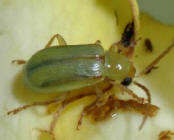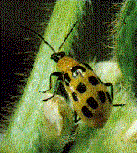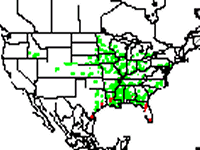

To send a message to an author, click on the author's name at the end of the article.
This Month in Ag Connection | Ag Connection - Other Issues Online
Missouri horticulturists have been pleasantly surprised by the recovery of most of the woody plants to the unprecedented freezing event of early April. But, look for lingering effects. Trees will be especially prone to shoots emerging from the base of the tree and on the trunk. These should be promptly removed to force growth and recovery up in the canopy. If canopy growth is sparse it may be best to wait until next year to reshape the tree or shrub. The growth in the canopy is tending to be softer than what is normal in the summer due to its late emergence and the resulting rapid growth. Thus a greater incidence of leaf and twig drop this June and July is expected.
In April and early May there was some concern that certain trees, even mature ones, would be killed. Some trees were quite slow to recover, such as sweet gum, dawn redwoods, ginkos, white oaks, and magnolias, but the only reports of complete death are on maples. Small, newly transplanted maples, especially Japanese, were the most susceptible, and many nurseries were not offering to honor survival guarantees for this spring freeze incident. New growth occurred fairly quickly on most maples, but there have been reports on larger trees with no growth following that which was frosted. A number of years ago several Norway maples in the Springfield area, about 4 inch diameter, were killed to the ground by a late freeze. These trees did sprout from the base. Maple trunks at just the right stage of spring growth may have bark, and the underlying tissue is damaged, and the tree is effectively girdled. Complete death of mature trees probably indicates the tree was in a weakened state already. Chris Starbuck, MU's state woody plant specialist, expects to see some frost stressed trees dying this year and next, succumbing from the further natural stresses of insects, disease and moisture.
Another lingering effect of the freeze is the production of food for wildlife by woody plants. This was partially addressed in an April article by Missouri Department of Conservation 'Weather Deals Tough, But Not Fatal, Blows to Wild Missouri'. The most serious impact from the freeze on wildlife anticipated was a reduction of acorns and other "mast," fruits that provide food for everything from deer and turkeys to rodents and insects. Acorns are the primary type of "hard mast" - durable fruits from trees and shrubs. In any given year there is a certain amount of natural crop insurance built into Missouri's oak-dominated forests. White oaks produce fruit from flower buds that grow and mature in the same year. Red oak acorns come from flowers that formed the previous spring. So, while this year's white oak acorn crop could be dramatically reduced in some parts of southern Missouri, acorns from red oaks likely will help buffer the loss. With maple flowers frosted, the squirrels did not have those seeds, as well as others, to consume in June, and they responded by increasing their foraging on the ground. A number of bird species not normally seen at bird feeders were reported this spring. They typically dwell and feed in the forest canopy. It just wasn't there! Crabapple trees set little if any fruit, thus this common winter food supply is gone. You might expect to see some unusual, and perhaps, bothersome behavior by squirrels, birds and deer in and around yards and gardens over the next year.
(Author: Jim Quinn, Horticulture Specialist)
This Month in Ag Connection | Ag Connection - Other Issues Online
Sustainable agriculture means different things to different people. When sustainable agriculture is mentioned, many people view it as "Hippie Agriculture" or "Organic Farming". Sustainable agriculture will not fit in the same mold for every farm. A well-balanced "traditional" farming operation can be sustainable.
To be sustainable, an operation must meet three objectives: economic profit, social benefits to the farm family and community, and environmental conservation. A whole system approach must be used when looking at these three objectives. If there is an imbalance among them, the system will not be sustainable. When observing and measuring the system to determine sustainability the following indicators could be used:
Economic Sustainability
Social Sustainability
Environmental Sustainability
These three objectives generally overlap, thus should be managed together. To be economically sustainable, profitable enterprises should be chosen along with good financial planning. Social sustainability can be achieved by buying feed locally, hiring local people and having quality of life goals in mind. Environmental sustainability can be achieved by having cover crops, increasing biodiversity, having crop rotations and the use of integrated pest management. When one of these objectives is ignored or the farm emphasizes one objective, it will be likely that areas in all the categories will be hurt. When issues arise on your farm, it may be beneficial to stop and examine what objective may have been ignored and decide how to fix the broken link in your farm's sustainability.
For more information call your local extension office or visit:
(Author: Randa Brunkhorst, Ag Business Specialist)
This Month in Ag Connection | Ag Connection - Other Issues Online
The recently enacted "U S Troop Appropriations Bill" contains numerous other provisions impacting a wide array of individuals and businesses. The bill contains two tax-related provisions of interest and value for farmers and other small business owners.
The first provision, also the one that will impact the greatest number of businesses, increases the 2007 Section 179 deduction from $112,000 to $125,000. Additionally, the maximum annual investment in qualifying property is also increased from $450,000 to $500,000. There is a continuing dollar for dollar phase-out for investments in qualifying assets over the $500,000 amount. The Section 179 provision is of significant tax planning value to small businesses. Really large businesses frequently will make annual investments in qualifying property greater than $625,000 thus eliminating the Section 179 deduction available on their tax return.
The second provision is more for show than dough - for most taxpayers. This provision allows a husband and wife, both materially participating in a sole proprietorship business, to each report one-half of the income and expenses on separate Schedule Fs or Schedule Cs. Prior to this legislation, a husband and wife operating a sole proprietorship together had to report the income and expense on either the husband's or the wife's business schedule, but not both. Previously the only way they could split the income was to file a partnership tax return. So this provision does provide some tax simplification.
However, couples will want to give considerable thought to the self-employment tax costs and the probable impact on Social Security retirement benefits before electing to split the reporting of business income and expenses.
The last tax provision is getting substantial debate around the State of Missouri. This bill, passed by the Missouri House and Senate, is now sitting on the governor's desk (June 21) - is the Qualified Beef Tax Credit. This bill, if signed by the governor, provides a Missouri tax credit to beef producers if they retain their calves and sell them at a weight greater than 450 pounds. The credit would be equal to 10 cents per pound for weights of qualified animals above 450 pounds. Qualifying beef animals are defined as an animal born in this state after August 28, 2008 that was raised and backgrounded or finished in this state - that weighs more than 450 pounds, excluding any beef animal more than thirty months of age.
If the total claimed beef tax credits from all qualified producer/applicants exceeds $10 million in any year, the $10 million will be prorated among the qualified producer/applicants.
(Author: Parman Green, Ag Business Specialist)
This Month in Ag Connection | Ag Connection - Other Issues Online
Northern and western rootworm beetles are serious pests of corn. There has been some confusion about the appearance and life cycle of the rootworm beetles. Northern corn rootworms are light green and the western rootworm are yellowish with black stripes on its back that have usually grown together to make the back black. Older photographs of the western corn rootworm beetle will show the distinct three stripes.


Northern and western corn rootworm beetles over winter in the egg stage. Rotation between corn and soybean has been an effective method of cultural control. States with a higher percent of continuous corn have had much more serious problems with corn rootworm damage. Now the eggs are beginning to survive two years in the soil waiting for the rotation back to corn. This is called extended diapause and is more of a problem in other states. Numerous adult beetles occasionally attack the developing silks and interrupt pollination.
Southern (corn) rootworm beetles are light green with 13 distinct spots on its back and slightly larger than the other two. Southern rootworm beetles overwinter as adult beetles. They can be found on warm late winter or early spring days. Southern rootworm beetles are usually thought of as garden pests and are known as the spotted cucumber beetle. Their larvae also feed on roots but are more associated with the beetles above ground foliar damage and disease transmission.
Controls are rotations, soil and foliar insecticides, and transgenic corn. In the past, rotations have been effective. Foliar sprays are used to protect silks. The introduction of rootworm resistant, transgenic varieties may protect us from the impact of extended diapause rootworms and provide adequate control for rootworms in continuous corn.
(Author: Jim Jarman, Agronomy Specialist)
This Month in Ag Connection | Ag Connection - Other Issues Online

USDA has a soybean rust web site: http://sbrusa.net/cgi-bin/sbr/public.cgi. Current information on detections and movement is available on this web page. A US map with current sentinel (rust survey fields) and detections is updated on a regular basis.
The soybean rust situation can change fast. Following the most current detections and movements over the USDA soybean rust web site is the best way to keep informed and monitor local situation. Contact your local UM Extension agronomy specialist.
(Author: Jim Jarman, Agronomy Specialist)
This Month in Ag Connection | Ag Connection - Other Issues Online
Publishing Information
Ag Connection is published monthly for Northeast and Central areas of Missouri producers and is supported by the University of Missouri Extension, the Missouri Agricultural Experiment Station, and the MU College of Agriculture, Food and Natural Resources. Managing Editor: Mary Sobba.